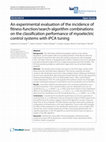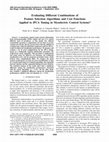Research Papers by Guillermo Camacho

Background: The information of electromyographic signals can be used by Myoelectric Control Syste... more Background: The information of electromyographic signals can be used by Myoelectric Control Systems (MCSs) to actuate prostheses. These devices allow the performing of movements that cannot be carried out by persons with amputated limbs. The state of the art in the development of MCSs is based on the use of individual principal component analysis (iPCA) as a stage of pre-processing of the classifiers. The iPCA pre-processing implies an optimization stage which has not yet been deeply explored. Methods: The present study considers two factors in the iPCA stage: namely A (the fitness function), and B (the search algorithm). The A factor comprises two levels, namely A 1 (the classification error) and A 2 (the correlation factor). Otherwise, the B factor has four levels, specifically B 1 (the Sequential Forward Selection, SFS), B 2 (the Sequential Floating Forward Selection, SFFS), B 3 (Artificial Bee Colony , ABC), and B 4 (Particle Swarm Optimization, PSO). This work evaluates the incidence of each one of the eight possible combinations between A and B factors over the classification error of the MCS. Results: A two factor ANOVA was performed on the computed classification errors and determined that: (1) the interactive effects over the classification error are not significative (F 0.01,3,72 = 4.0659 > f AB = 0.09), (2) the levels of factor A have significative effects on the classification error (F 0.02,1,72 = 5.0162 < f A = 6.56), and (3) the levels of factor B over the classification error are not significative (F 0.01,3,72 = 4.0659 > f B = 0.08). Conclusions: Considering the classification performance we found a superiority of using the factor A 2 in combination with any of the levels of factor B. With respect to the time performance the analysis suggests that the PSO algorithm is at least 14 percent better than its best competitor. The latter behavior has been observed for a particular configuration set of parameters in the search algorithms. Future works will investigate the effect of these parameters in the classification performance, such as length of the reduced size vector, number of particles and bees used during optimal search, the cognitive parameters in the PSO algorithm as well as the limit of cycles to improve a solution in the ABC algorithm.

Resumen un inversor trifásico es un dispositivo que genera una señal sinusoidal con amplitud y fr... more Resumen un inversor trifásico es un dispositivo que genera una señal sinusoidal con amplitud y frecuencia variable a partir de fuentes DC. este dispositivo es parte fundamental de los accionamientos eléctricos responsables por las aplicaciones de control de velocidad en la industria. Actualmente, los investigadores de esta área están experimentando dificultades al tratar de comparar las diferentes técnicas de modulación de inversores trifásicos reportadas en la literatura. en respuesta a esta situación se presenta un conjunto de características que facilita dicha comparación. A partir del análisis de las técnicas de modulación (PWm), se propone un esquema de clasificación basado en cinco características. se espera que este grupo de características facilite tanto el proceso de comparación entre las técnicas de modulación, así como el desarrollo de nuevos algoritmos que aporten a la evolución de propuestas en esta área.

A myoelectric control system extracts information from electromyographic (EMG) signals and uses i... more A myoelectric control system extracts information from electromyographic (EMG) signals and uses it to control different types of prostheses, so that people who suffered traumatisms, paralysis or amputations can use them to execute common movements. Recent research shows that the addition of a tuning stage, using the individual component analysis (iPCA), results in improved classification performance. We propose and evaluate a set of novel configurations for the iPCA tuning, based on a biologically inspired optimization procedure, the artificial bee colony algorithm. This procedure is implemented and tested using two different cost functions, the traditional classification error and the proposed correlation factor, which involves lower computational effort. We compare the tuned system's performance, in terms of correct classifications, to that of a system tuned using two standard algorithms, the sequential forward selection and the sequential floating forward selection. The statistical analyses of the results don't find a significant difference among the classification performances associated with the search algorithms (p < 0.01). On the other hand, they establish a significant difference among the classification performances related to the cost functions (p < 0.02).
Resumen-Este artículo presenta el diseño de un algoritmo de modulación híbrido que supera el dese... more Resumen-Este artículo presenta el diseño de un algoritmo de modulación híbrido que supera el desempeño armónico de ocho algoritmos de modulación por ancho de pulso (PWM) comunes en inversores con fuente de voltaje (VSI) de dos niveles en accionamientos eléctricos AC. A partir del análisis armónico de los ocho algoritmos se establece una metodología para diseñar un esquema de modulación híbrido que ofrece mejoras en el desempeño armónico. El algoritmo diseñado es analizado teórica y experimentalmente mediante cálculo del factor de distorsión armónica total y medición del índice de distorsión armónica de corriente , respectivamente.
Teaching Documents by Guillermo Camacho
Esta guía ha sido preparada con el propósito de servir como referencia para el desarrollo del mód... more Esta guía ha sido preparada con el propósito de servir como referencia para el desarrollo del módulo ISA S88 dentro de la electiva CONTROL DISTRIBUIDO. Se asume que la información aquí contenida será complementada con las lecturas y las discusiones desarrolladas durante las cátedras relacionadas.
La presente guía tiene como propósito presentar una metodología para la construcción de un sistem... more La presente guía tiene como propósito presentar una metodología para la construcción de un sistema SCADA con los módulos fundamentales: (a) mímicos de proceso, (b) tendencias, (c) alarmas y (d) registro de variables hacia bases de datos. Para facilitar la presentación de la metodología se ha seleccionado un proceso industrial simple como caso de estudio. Adicionalmente, se ha decidido utilizar como plataforma de desarrollo la aplicación FactoryTalk View SE (Site Edition), sin ser esto una restricción para la metodología.
Drafts by Guillermo Camacho
Resumen: Esta guía resume el proceso de configuración de Matlab con el osciloscopio LeCroy 9310CM... more Resumen: Esta guía resume el proceso de configuración de Matlab con el osciloscopio LeCroy 9310CM a través de GPIB y presenta un ejemplo de adquisición de datos hacia el entorno de Matlab para posterior procesamiento. Los requerimientos del sistema son:






Uploads
Research Papers by Guillermo Camacho
Teaching Documents by Guillermo Camacho
Drafts by Guillermo Camacho